
Our sound investment principles are based on decades of academic research and a clear understanding of the proven strength of passive investment management. There are two schools of thought in the investment industry:
ACTIVE MANAGEMENT VS. PASSIVE INVESTMENT MANAGEMENT
Active management embraces the idea that a person can achieve superior results over the market by picking winning stocks. In contrast, passive investment management focuses on delivering consistent market returns by developing properly allocated portfolios made up of low cost exchange traded funds (ETFs) and index mutual funds.
Most investors, both institutional and individual will find the best way to own common stocks is through an index fund that charges minimal fees. Those following this path are sure to beat the net results (after fees and expenses) delivered by the great majority of investment professionals.” —Warren Buffett, Chairman, Berkshire Hathaway
The chart below illustrates that chasing the returns of active management is a losing proposition

The chart shows three separate asset class comparisons of active vs. passive investing over a five year period (12/31/10 – 12/31/15). The gray area shows the percentage of actively managed funds that beat their designated benchmark, while the white area indicates the percentage of actively managed funds that under-performed their benchmark, thus proving the passive investment management approach as the better alternative. Source: S&P Indices, CRSP for 12/10 – 12/15.
With such overwhelming evidence, it is easy to see why FIDELIS iM applies the proven strengths of a passive approach to investment management. Our approach is market tested to be sound, rather than driven by Wall Street whims and impulses. What we know is that a disciplined, diversified investment process utilizing low cost ETFs and index funds provides you the best opportunity to meet your goals.